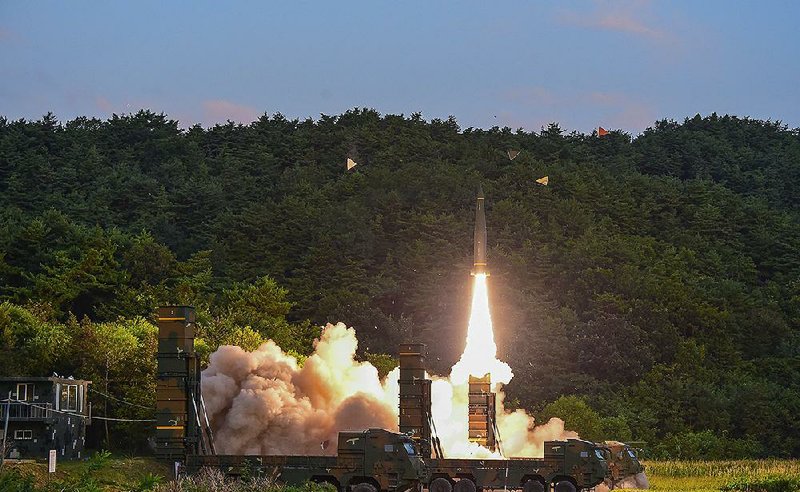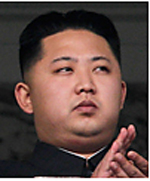North Korea's leader, Kim Jong Un, "is begging for war," Nikki Haley, the U.S. ambassador to the United Nations, told the Security Council on Monday.
Haley said the U.S. would look at countries doing business with the North -- which include China -- and planned to circulate a resolution this week with the goal of getting it approved Monday. Senior administration officials said the draft resolution was expected to include calling for China and other members of the council to cut off all oil and other fuels to North Korea.
"Enough is enough. War is never something the United States wants. We don't want it now. But our country's patience is not unlimited," Haley said.
Her remarks came a day after the North's most powerful nuclear test, and hours after South Korean officials told lawmakers that North Korea might be preparing to launch another ballistic missile to mark the anniversary of the founding of the North's government in the coming days.
[PRESIDENT TRUMP: Timeline, appointments, executive orders + guide to actions in first 200 days]
In Seoul, Chang Kyung-soo, an official with South Korea's Defense Ministry, told lawmakers that it was seeing preparations in the North for an intercontinental ballistic missile test, but didn't provide details about how officials had reached that assessment. Chang also said the yield from the latest nuclear detonation appeared to be about 50 kilotons, which would mark a "significant increase" from North Korea's past nuclear tests.
"We have kicked the can down the road long enough," Haley told the Security Council in an emergency meeting. "There is no more road left."
Haley did not threaten unilateral military action by Washington or repeat President Donald Trump's statement on Twitter that South Korea's call for more diplomacy was a form of "appeasement." She said instead that "the time has come for us to exhaust all of our diplomatic means before it's too late."
It was the second time in less than a week that the Security Council had met to discuss North Korea, and the 10th time it has done so this year.
Koro Bessho, the Japanese ambassador to the U.N., also stopped short of threatening imminent military action but said the danger from North Korea had been "raised to an unprecedented level" and was "a grave threat to the peace and the security of the world."
Cho Tae-yul, the South Korean ambassador to the U.N., described the North's latest test as "do-or-die behavior."
He called for "truly biting and robust measures that Pyongyang finds really painful," including blocking the flow of any money that might finance the North's weapons program.
The U.S. resolution faces an uncertain future. Russia and China have both proposed a two-pronged approach: North Korea would suspend its nuclear and missile development, and the United States and South Korea would suspend their joint military exercises.
Haley ruled out the "freeze for freeze" proposal backed by China and Russia. "When a rogue regime has a nuclear weapon and an ICBM pointed at you, you do not take steps to lower your guard. No one would do that. We certainly won't," she said.
SIMULATED ATTACK
The South Korean military carried out drills at dawn Monday, with F-15K fighter jets and ground forces firing missiles into the Sea of Japan in a simulated attack on the North's nuclear site.
The South Korean military calculated the distance to the test site at Punggye-ri and practiced having jet fighters accurately hit the target, the nation's Joint Chiefs of Staff said.
The South Korean air force plans to stage a live-fire drill, launching Taurus air-to-surface guided missiles from its F-15K fighters, later this month, the defense ministry said Monday. The missiles have a range of 300 miles -- enough to carry out precision strikes on North Korea's key nuclear and missile sites.
Today, Seoul continued its displays of military capability with warships conducting live-fire exercises at sea.
A 2,500-ton frigate, a 1,000-ton patrol ship and 400-ton guided-missile vessels participated in drills off the east coast aimed at retaliating against potential North Korean provocations, the Defense Ministry said. The ministry said more naval drills are planned from Wednesday to Saturday in the country's southern seas.
The country's president, Moon Jae-in, talked with Trump by telephone on Monday evening, the South Korean leader's office said. The White House said Trump also spoke with German Chancellor Angela Merkel.
"President Trump reaffirmed the United States' ironclad commitment to defend South Korea," said Park Soo-hyun, a spokesman for Moon. "The two leaders also agreed to push for maximum pressure and sanctions against North Korea and a stronger sanctions resolution at the United Nations Security Council."
During the call, the spokesman said, Trump resolved a major South Korean grievance by agreeing to let it build more powerful non-nuclear ballistic missiles.
Under a treaty with the United States that was aimed at preventing a regional arms race, South Korea has been able to build ballistic missiles only with a range of up to 497 miles. Those missiles' payloads were not allowed to exceed 500 kilograms, about half a ton.
On Monday, Trump agreed to lift the upper limit on the payload, Park said. Moon agreed to help the United States complete the deployment of a missile defense system as soon as possible.
They also agreed to work together to punish North Korea for Sunday's nuclear test, including by pushing for tougher sanctions through the United Nations.
Trump and Moon "agreed to maximize pressure on North Korea using all means at their disposal," according to a White House statement. Trump "provided his conceptual approval" for South Korea to buy "many billions of dollars' worth of military weapons and equipment" from the U.S.
TACTICAL NUKES
South Korea's defense minister on Monday said it was worth reviewing the redeployment of American tactical nuclear weapons to the Korean Peninsula to guard against the North, a step that analysts warn would sharply increase the risk of an accidental conflict.
Testifying before South Korea's National Assembly, Defense Minister Song Young-moo said he had told his U.S. counterpart, James Mattis, in a meeting last week that the United States needed to send long-range bombers, aircraft carriers and other strategic assets to the Korean Peninsula more often or regularly to reassure the South Koreans.
He said he had told Mattis that many in his country were calling for the reintroduction of U.S. tactical nuclear weapons to South Korea.
"I told him that it would be good for strategic assets to be sent regularly to the Korean Peninsula and that some South Korean lawmakers and media are strongly pushing for tactical nuclear weapons [to be redeployed]," Song said, without disclosing Mattis' response.
Song appeared to throw his support behind the idea on Monday.
"The redeployment of tactical nuclear weapons is an alternative worth a full review," Song said.
The United States had about 100 weapons, including short-range artillery with nuclear warheads and gravity bombs, stationed in South Korea until 1991. President George H.W. Bush signed the Presidential Nuclear Initiative and withdrew all naval and land-based tactical nuclear weapons that had been deployed abroad.
After the defense minister spoke at the hearing, the South Korean president's office said that it was not considering redeploying tactical nuclear weapons. "Our government's firm stance on the nuclear-free peninsula remains unchanged," said Kim Dong-jo, a spokesman for Moon.
Military experts in the United States are almost universally opposed to the idea of deploying such weapons in South Korea.
"The thing that most concerns me about redeployment is that it introduces more room for miscalculation or unintended escalation," said Catherine Dill of the Center for Nonproliferation Studies in Monterey, Calif.
A growing number of policymakers in Seoul say that, if it comes under attack from North Korea, South Korea can't wait the two-plus hours it would take American bombers to arrive from their base on the Pacific island of Guam.
"We need these strategic or tactical assets that can destroy North Korea's nuclear-capable missiles before they can inflict harm on us," said Chun Yung-woo, a nuclear expert and former South Korean national security adviser.
"Right now they can retaliate but by that time, tens of thousands of people might have been killed," Chun said. "We need a first layer of offensive weapons stationed closer to North Korea's nuclear and missile sites."
Information for this article was contributed by Sewell Chan, Austin Ramzy, Choe Sang-hun and David E. Sanger of The New York Times; by Maria Sanminiatelli, Jennifer Peltz, Youkyung Lee, Foster Klug and Kim Tong-hyung of The Associated Press; by Anna Fifield and Yoonjung Seo of The Washington Post; and by Shinhye Kang, Seyoon Kim and Erik Wasson of Bloomberg News.
A Section on 09/05/2017


